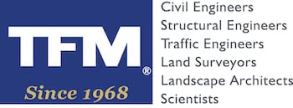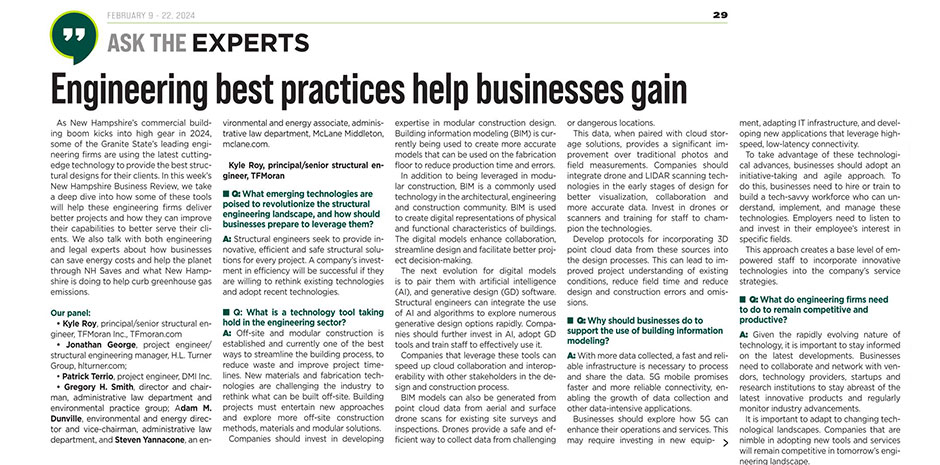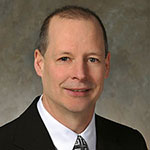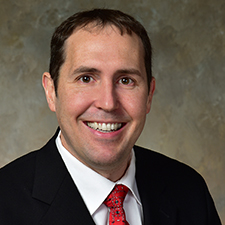New Hampshire Business Review‘s February 9th issue features an engineering spotlight, with input from numerous New Hampshire engineering professionals. Principal and Senior Structural Engineer, Kyle Roy gave his thoughts on engineering best practices and how businesses gain from these practices. Read Kyle’s insight below:
Ask the Experts: Engineering Best Practices Help Businesses Gain
As New Hampshire’s commercial building boom kicks into high gear in 2024, some of the Granite State’s leading engineering firms are using the latest cutting-edge technology to provide the best structural designs for their clients. In this week’s New Hampshire Business Review, we take a deep dive into how some of these tools will help these engineering firms deliver better projects and how they can improve their capabilities to better serve their clients. We also talk with both engineering and legal experts about how businesses can save energy costs and help the planet through NH Saves and what New Hampshire is doing to help curb greenhouse gas emissions.
Q: What emerging technologies are poised to revolutionize the structural engineering landscape, and how should businesses prepare to leverage them?
A: Structural engineers seek to provide innovative, efficient and safe structural solutions for every project. A company’s investment in efficiency will be successful if they are willing to rethink existing technologies and adopt recent technologies.
Q: What is a technology tool taking hold in the engineering sector?
A: Off-site and modular construction is established and currently one of the best ways to streamline the building process, to reduce waste and improve project timelines. New materials and fabrication technologies are challenging the industry to rethink what can be built off-site. Building projects must entertain new approaches and explore more off-site construction methods, materials and modular solutions.
Companies should invest in developing expertise in modular construction design. Building information modeling (BIM) is currently being used to create more accurate models that can be used on the fabrication floor to reduce production time and errors.
In addition to being leveraged in modular construction, BIM is a commonly used technology in the architectural, engineering and construction community. BIM is used to create digital representations of physical and functional characteristics of buildings. The digital models enhance collaboration, streamline design and facilitate better project decision-making.
The next evolution for digital models is to pair them with artificial intelligence (AI), and generative design (GD) software. Structural engineers can integrate the use of AI and algorithms to explore numerous generative design options rapidly. Companies should further invest in AI, adopt GD tools and train staff to effectively use it.
Companies that leverage these tools can speed up cloud collaboration and interoperability with other stakeholders in the design and construction process.
BIM models can also be generated from point cloud data from aerial and surface drone scans for existing site surveys and inspections. Drones provide a safe and efficient way to collect data from challenging or dangerous locations.
This data, when paired with cloud storage solutions, provides a significant improvement over traditional photos and field measurements. Companies should integrate drone and LIDAR scanning technologies in the early stages of design for better visualization, collaboration and more accurate data. Invest in drones or scanners and training for staff to champion the technologies.
Develop protocols for incorporating 3D point cloud data from these sources into the design processes. This can lead to improved project understanding of existing conditions, reduce field time and reduce design and construction errors and omissions.
Q: What should businesses do to support the use of building information modeling?
A: With more data collected, a fast and reliable infrastructure is necessary to process and share the data. 5G mobile promises faster and more reliable connectivity, enabling the growth of data collection and other data-intensive applications.
Businesses should explore how 5G can enhance their operations and services. This may require investing in new equipment, adapting IT infrastructure, and developing new applications that leverage high-speed, low-latency connectivity.
To take advantage of these technological advances, businesses should adopt an initiative-taking and agile approach. To do this, businesses need to hire or train to build a tech-savvy workforce who can understand, implement, and manage these technologies. Employers need to listen to and invest in their employee’s interest in specific fields.
This approach creates a base level of empowered staff to incorporate innovative technologies into the company’s service strategies.
Q: What do engineering firms need to do to remain competitive and productive?
A: Given the rapidly evolving nature of technology, it is important to stay informed on the latest developments. Businesses need to collaborate and network with vendors, technology providers, startups and research institutions to stay abreast of the latest innovative products and regularly monitor industry advancements.
It is important to adapt to changing technological landscapes. Companies that are nimble in adopting new tools and services will remain competitive in tomorrow’s engineering landscape.
Check out the rest of the article here.





